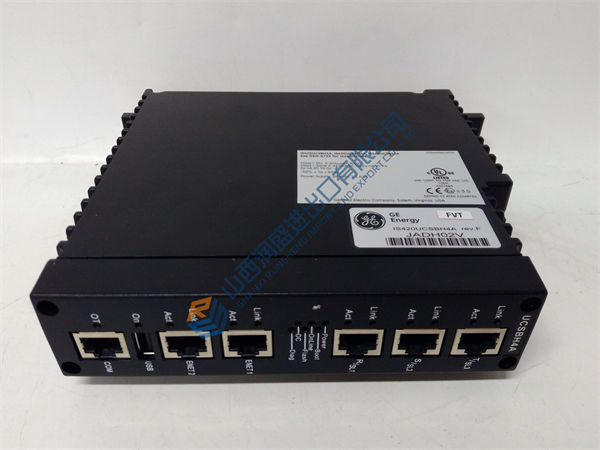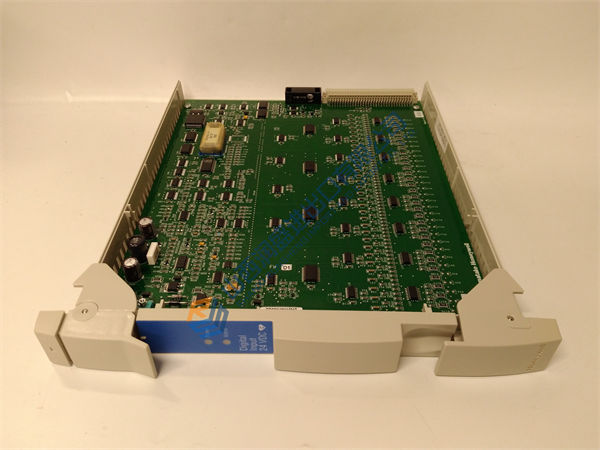The Triconex 4201-3 is a specific variant of the Triconex 4201 Fiber Optic Remote Extender Module (RXM). While the core functionality remains the same as the 4201 (extending I/O communication over fiber optics in Triconex Safety Instrumented Systems), the “-3” typically denotes a specific revision, configuration, or minor variation within the 4201 series. It maintains the critical attributes of high reliability, safety integrity, and long-distance communication essential for critical industrial applications.
Product Overview
The Triconex 4201-3 Fiber Optic Remote Extender Module (RXM) is an advanced and highly reliable component within Triconex Safety Instrumented Systems (SIS), designed to facilitate secure and high-speed communication between the main Triconex controller chassis and remote I/O modules over significant distances using fiber optic technology. This module, a specific revision of the 4201 series from Triconex (now part of Schneider Electric), serves as a crucial repeater and extender for the Tricon I/O bus. It enables distributed control and data acquisition for safety-critical processes such as Emergency Shutdown (ESD) systems, Fire and Gas (F&G) detection, and complex turbomachinery control. The 4201-3 is meticulously engineered to ensure signal integrity, provide vital ground loop isolation, and maintain robust communication in electrically noisy and harsh industrial environments. By leveraging fiber optics, the Triconex 4201-3 enhances system architecture flexibility, allowing for geographically dispersed I/O without compromising the stringent safety and availability requirements of SIL3 or SIL4 applications. Its role is fundamental in minimizing the risk of system failures and enhancing overall plant safety by ensuring uninterrupted, accurate, and error-free signal transmission for critical process operations.
Technical Specifications
Main Features and Advantages
The Triconex 4201-3 Fiber Optic Remote Extender Module offers a suite of advanced features and compelling advantages, making it an essential component for high-integrity safety systems requiring extended I/O capabilities.
Extended Communication Range via Fiber Optics: The most significant feature of the 4201-3 is its capability to extend the Tricon I/O bus over long distances, typically up to 2 kilometers or even further, using fiber optic cables. This overcomes the limitations of traditional copper wiring, allowing I/O modules to be strategically placed closer to field devices, even in vast industrial complexes. Fiber optic communication also provides inherent immunity to electromagnetic interference (EMI) and radio frequency interference (RFI), ensuring pristine signal quality in electrically noisy environments.
Enhanced System Architecture Flexibility: By enabling remote I/O, the 4201-3 significantly enhances the flexibility of designing Safety Instrumented System (SIS) architectures. This allows for optimized wiring schemes, reduced cabling costs, and simpler installation. It facilitates the creation of distributed safety systems, which can be particularly advantageous in large-scale plants or hazardous areas where centralizing all I/O is impractical or unsafe.
Ground Loop Isolation for Signal Integrity: The fiber optic medium utilized by the 4201-3 naturally provides complete electrical isolation between the main controller chassis and the remote I/O. This effectively eliminates ground loop issues, which can introduce noise, signal distortion, and potential hazards in electrically diverse industrial settings. The resulting clean and reliable signal transmission is paramount for the accuracy and integrity of safety-critical data.
Comprehensive Onboard Diagnostics: The 4201-3 includes dedicated diagnostic indicators (such as PASS, FAIL, ACTIVE, TX, RX1, RX2, RX3) that provide real-time visual feedback on the module’s operational status and the health of its fiber optic communication links. These intuitive diagnostics aid in rapid fault identification and troubleshooting, significantly reducing mean time to repair (MTTR) and contributing to higher system availability.
High Reliability and Safety Certifications: As part of the Triconex family, the 4201-3 is engineered to meet stringent safety integrity levels (SIL3/SIL4 capable, depending on the overall system configuration). Its robust construction and integration into a Triple Modular Redundant (TMR) architecture ensure fault-tolerant operation, preventing spurious trips while guaranteeing that safety functions execute reliably when demanded. This adherence to global safety standards is critical for protecting personnel, plant assets, and the environment.

Application Field
The Triconex 4201-3 Fiber Optic Remote Extender Module is a cornerstone component in a wide array of industrial applications where mission-critical safety and high-integrity control are paramount, especially when I/O points are geographically dispersed or located in hazardous zones.
In the oil and gas industry, from offshore platforms and onshore production facilities to refineries and pipelines, the 4201-3 is extensively utilized in Emergency Shutdown (ESD) systems. It enables remote communication with sensors and actuators in remote wellheads, processing units, or tank farms, ensuring rapid and reliable shutdown responses to critical events like overpressure, fire, or gas leaks. It is also vital for Fire and Gas (F&G) detection systems in these environments.
Within petrochemical and chemical plants, the 4201-3 plays a crucial role in managing highly hazardous processes. It supports safety interlocks and process shutdown mechanisms for reactors, distillation columns, and other critical process units, allowing for safe and reliable remote monitoring and control across expansive and complex plant layouts.
For the power generation sector, encompassing conventional thermal, nuclear, and renewable energy facilities, the 4201-3 is deployed in critical control applications such as Boiler Management Systems (BMS), Turbine Control Systems (TCS), and generator protection. It ensures the secure and timely transmission of safety-related signals for starting, operating, and shutting down large-scale power generation assets, contributing to grid stability and personnel safety.
The mining and metallurgy industries also leverage the 4201-3 for safety systems associated with heavy machinery, mineral processing, and materials handling, particularly in expansive or physically challenging environments where robust, long-distance communication is essential for worker safety and operational continuity.
Broadly, any large industrial facility that requires a certified Safety Instrumented System with geographically distributed I/O will benefit from the Triconex 4201-3. Its ability to deliver secure, high-integrity communication over fiber optics ensures that critical safety data is transmitted reliably and without delay to the central controller, even under the most demanding conditions.
Related Products
The Triconex 4201-3 is an integral part of the comprehensive Triconex Safety Instrumented System (SIS) and is designed for seamless integration with other modules and platforms within this highly reliable family of products.
Triconex Tricon Controllers (e.g., Tricon v10, Tricon CX): These Triple Modular Redundant (TMR) controllers are the central processing units with which the 4201-3 communicates, forming the core of the SIS. Triconex Digital Input/Output Modules (e.g., 3501E, 3604E, 3625): The 4201-3 extends the communication reach for these digital I/O modules, allowing them to be located remotely from the main controller. Triconex Analog Input/Output Modules (e.g., 3700A, 3805E): Similarly, the 4201-3 facilitates remote communication for analog I/O points, enabling distributed monitoring and control of continuous process variables. Triconex RXM Chassis: The 4201-3 is physically installed within a dedicated RXM chassis, which also houses the remote I/O modules connected via the extender. Triconex Communication Interface Modules (e.g., 4119A, CIM3211S2): While the 4201-3 handles remote I/O bus extension, other communication modules provide interfaces to Distributed Control Systems (DCS), PLCs, or other supervisory systems via various industrial protocols. Triconex TriStation Software: This engineering workstation software is the primary tool used for configuring, programming, diagnosing, and maintaining the entire Triconex system, including the modules connected via the 4201-3. Triconex Power Supply Modules (e.g., 8310, 8311): These modules are essential for providing the stable and redundant power necessary for the operation of the 4201-3 and other modules within the RXM chassis. Triconex 4201: The base model from which the 4201-3 is derived, representing the original Fiber Optic Remote Extender Module. The “-3” often indicates a specific version or minor enhancement.
Installation and Maintenance
Pre-installation preparation: Before installing the Triconex 4201-3 Fiber Optic Remote Extender Module, it is critical to adhere to all relevant safety procedures, including complete power lockout of the Triconex system and its associated I/O chassis. The RXM chassis, which will house the 4201-3, must be securely mounted within a suitable industrial enclosure that protects it from environmental extremes, such as excessive temperature, humidity, and vibration, as specified by Triconex. Confirm that the chosen fiber optic cable (typically multi-mode for the 4201-3) and its ST connectors are compatible, of the correct length, and free from damage. During cable routing, avoid sharp bends or undue stress on the fiber, which can impair signal integrity. Before connecting, meticulously clean the fiber optic connector end faces on both the 4201-3 and the cables using appropriate fiber optic cleaning tools. Verify that the power supply for the RXM chassis is adequately sized and correctly wired to deliver a stable 24 VDC. Always consult the official Triconex installation and planning guides for detailed instructions, paying particular attention to mechanical keying features that prevent improper module insertion.
Maintenance recommendations: Ongoing maintenance for the Triconex 4201-3 primarily involves ensuring the integrity of its fiber optic connections and maintaining suitable environmental conditions to preserve reliable communication. Regular visual inspections are recommended to check the fiber optic cables for any physical damage, kinks, or signs of stress, and to confirm that the ST connectors are clean and securely seated. Periodic cleaning of the fiber optic connector end faces using specialized cleaning kits is vital, as even microscopic dust can significantly degrade signal quality. Continuously monitor the diagnostic indicators on the 4201-3 (PASS, FAIL, ACTIVE, TX, RX1, RX2, RX3); any deviation from the expected status should prompt an immediate and thorough investigation. Ensure that the cooling within the RXM chassis is effective and that any ventilation openings are unobstructed by dust or debris to prevent overheating. While the 4201-3 is designed for high reliability, in the event of a detected fault, its modular design typically supports online replacement, minimizing system downtime. Always follow Triconex’s documented procedures for hot-swapping modules to preserve system integrity and safety.
Product Guarantee
The Triconex 4201-3 Fiber Optic Remote Extender Module is supported by a comprehensive product guarantee from Triconex (now a part of Schneider Electric), reflecting our deep-seated commitment to delivering components of the highest quality, safety, and operational reliability. Each 4201-3 module undergoes stringent manufacturing processes and rigorous testing to ensure its robust performance and strict adherence to the demanding requirements of safety-critical applications in diverse industrial environments. This unwavering dedication to quality is substantiated by our standard warranty coverage, which protects against manufacturing defects and material faults, providing customers with unwavering confidence in the long-term integrity and functionality of their investment. Beyond the initial purchase, Triconex provides extensive and responsive after-sales support for the 4201-3, offering expert technical assistance for seamless installation, correct configuration, effective troubleshooting, and optimal system performance. Our expansive global service network ensures prompt access to professional support and, when necessary, original spare parts or replacement units, thereby significantly minimizing potential downtime and maximizing the sustained availability of your critical safety instrumented systems. Choosing the Triconex 4201-3 represents an investment in a proven, high-integrity solution from a world leader in process safety, designed to deliver unparalleled reliability and contribute significantly to your plant’s overall safety and continuous operational efficiency.






